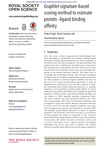Graphlet signature based scoringmethod to estimate protein ligand binding affinity
| dc.contributor.author | Singh, Omkar | en_US |
| dc.contributor.author | Sawariya, Kunal | en_US |
| dc.contributor.author | Aparoy, Polamarasetty | en_US |
| dc.date.accessioned | 2016-07-18T06:49:12Z | |
| dc.date.available | 2016-07-18T06:49:12Z | |
| dc.date.issued | 2014 | en_US |
| dc.identifier.other | HPU4160458 | en_US |
| dc.identifier.uri | https://lib.hpu.edu.vn/handle/123456789/22303 | |
| dc.description.abstract | Over the years, various computational methodologies have been developed to understand and quantify receptor–ligand interactions. Protein–ligand interactions can also be explained in the form of a network and its properties. The ligand binding at the protein-active site is stabilized by formation of new interactions like hydrogen bond, hydrophobic and ionic. These non-covalent interactions when considered as links cause non-isomorphic sub-graphs in the residue interaction network. This study aims to investigate the relationship between these induced sub-graphs and ligand activity. | en_US |
| dc.format.extent | 9 p. | en_US |
| dc.format.mimetype | application/pdf | |
| dc.language.iso | en | en_US |
| dc.subject | Structural biology and biophysics | en_US |
| dc.subject | Bioinformatics | en_US |
| dc.subject | Theoretical biology | en_US |
| dc.subject | Computational biology | en_US |
| dc.subject | Graphlet signature | en_US |
| dc.subject | Interaction network | en_US |
| dc.subject | Docking | en_US |
| dc.subject | Binding affinity | en_US |
| dc.title | Graphlet signature based scoringmethod to estimate protein ligand binding affinity | en_US |
| dc.type | Article | en_US |
| dc.size | 780KB | en_US |
| dc.department | Education | en_US |
Files in this item
This item appears in the following Collection(s)
-
Education [806]

